Distinguishing the Multifactorial Impacts on Ecosystem Services under the Long-Term Ecological Restoration in the Gonghe Basin of China
Abstract
:1. Introduction
2. Materials and Methods
2.1. Study Area
2.2. Data Sources
2.3. Methods
2.3.1. Soil Conservation (SC)
2.3.2. Sand Fixation (SF)
2.3.3. Carbon Sequestration (CS)
2.3.4. Water Yield (WY)
2.3.5. Habitat Quality (HQ)
2.3.6. Overall Benefit of Ecosystem Services (OB)
2.3.7. Measures of ES Trade-Offs
2.3.8. Geographical Detector
3. Results
3.1. Spatiotemporal Dynamics of Ecosystem Services
3.1.1. Temporal Variations in Ecosystem Services
3.1.2. Spatial Variations in Ecosystem Services
3.2. Trade-Offs and Synergies among Ecosystem Services
3.2.1. Trade-Offs and Synergies at the Regional Scale
3.2.2. Trade-Offs and Synergies at the Pixel Scale
3.3. Impact Factors of Ecosystem Services
3.3.1. Single Factor Impact on Ecosystem Services
3.3.2. Double-Factor Interactional Impacts on Ecosystem Services
3.3.3. Suitability Zone Analysis
4. Discussion
4.1. Changes in Ecosystem Services
4.2. The Trade-Off and Synergy Relationship of Ecosystem Services
4.3. Impacts of Factors on Ecosystem Services
4.4. Limitations
5. Conclusions
Supplementary Materials
Author Contributions
Funding
Data Availability Statement
Acknowledgments
Conflicts of Interest
References
- Costanza, R.; d’Arge, R.; De Groot, R.; Farber, S.; Grasso, M.; Hannon, B.; Limburg, K.; Naeem, S.; O’neill, R.V.; Paruelo, J. The value of the world’s ecosystem services and natural capital. Nature 1997, 387, 253–260. [Google Scholar] [CrossRef]
- Millennium Ecosystem Assessment. Ecosystems and Human Well-Being; Island Press: Washington, DC, USA, 2005; Volume 5. [Google Scholar]
- Keesstra, S.; Nunes, J.; Novara, A.; Finger, D.; Avelar, D.; Kalantari, Z.; Cerdà, A. The superior effect of nature based solutions in land management for enhancing ecosystem services. Sci. Total Environ. 2018, 610, 997–1009. [Google Scholar] [CrossRef] [PubMed]
- Balkanlou, K.R.; Müller, B.; Cord, A.F.; Panahi, F.; Malekian, A.; Jafari, M.; Egli, L. Spatiotemporal dynamics of ecosystem services provision in a degraded ecosystem: A systematic assessment in the Lake Urmia basin, Iran. Sci. Total Environ. 2020, 716, 137100. [Google Scholar] [CrossRef] [PubMed]
- Staudinger, M.D.; Grimm, N.B.; Staudt, A.; Carter, S.L.; Chapin, F.S. Impacts of Climate Change on Biodiversity, Ecosystems, and Ecosystem Services; United States Global Change Research Program: Washington, DC, USA, 2012; p. 139. [Google Scholar]
- Mahmoud, S.H.; Gan, T.Y. Impact of anthropogenic climate change and human activities on environment and ecosystem services in arid regions. Sci. Total Environ. 2018, 633, 1329–1344. [Google Scholar] [CrossRef] [PubMed]
- Kuriqi, A.; Pinheiro, A.N.; Sordo-Ward, A.; Garrote, L. Water-energy-ecosystem nexus: Balancing competing interests at a run-of-river hydropower plant coupling a hydrologic–ecohydraulic approach. Energy Convers. Manag. 2020, 223, 113267. [Google Scholar] [CrossRef]
- Stringer, L.C.; Mirzabaev, A.; Benjaminsen, T.A.; Harris, R.M.; Jafari, M.; Lissner, T.K.; Stevens, N.; Tirado von der Pahlen, C. Climate change impacts on water security in global drylands. One Earth 2021, 4, 851–864. [Google Scholar] [CrossRef]
- Li, C.; Fu, B.; Wang, S.; Stringer, L.C.; Wang, Y.; Li, Z.; Liu, Y.; Zhou, W. Drivers and impacts of changes in China’s drylands. Nat. Rev. Earth Environ. 2021, 2, 858–873. [Google Scholar] [CrossRef]
- Reynolds, J.F.; Smith, D.M.S.; Lambin, E.F.; Turner, B.L.; Mortimore, M.; Batterbury, S.P.J.; Downing, T.E.; Dowlatabadi, H.; Fernández, R.J.; Herrick, J.E.; et al. Global Desertification: Building a Science for Dryland Development. Science 2007, 316, 847–851. [Google Scholar] [CrossRef]
- Poulter, B.; Frank, D.; Ciais, P.; Myneni, R.B.; Andela, N.; Bi, J.; Broquet, G.; Canadell, J.G.; Chevallier, F.; Liu, Y.; et al. Contribution of Semi-Arid Ecosystems to Interannual Variability of the Global Carbon Cycle. Nature 2014, 509, 600–603. [Google Scholar] [CrossRef]
- Li, C.; Fu, B.; Wang, S.; Stringer, L.C.; Zhou, W.; Ren, Z.; Hu, M.; Zhang, Y.; Rodriguez-Caballero, E.; Weber, B.; et al. Climate-Driven Ecological Thresholds in China’s Drylands Modulated by Grazing. Nat. Sustain. 2023, 6, 1363–1372. [Google Scholar] [CrossRef]
- Zhu, Z.; Chen, G. Sandy Desertification in China; Science Press: Beijing, China, 1994; pp. 20–33. [Google Scholar]
- Su, W.; Han, G.; Ye, D.; Cao, G. Remote sensing evaluation and driving force analysis of ecological environment in Gonghe Basin. J. Desert Res. 2023, 43, 74–84. [Google Scholar]
- Jia, H.; Wang, R.; Li, H.; Diao, B.; Zheng, H.; Guo, L.; Liu, L.; Liu, J. The Changes of Desertification and Its Driving Factors in the Gonghe Basin of North China over the Past 10 Years. Land 2023, 12, 998. [Google Scholar] [CrossRef]
- Liu, X.; Li, L.; Qin, F.; Li, Y.; Chen, J.; Fang, X. Ecological policies enhanced ecosystem services in the Hunshandak sandy land of China. Ecol. Indic. 2022, 14, 109450. [Google Scholar] [CrossRef]
- Li, S.; Yan, C.; Song, X.; Xie, J.; Duan, H. Remote Sensing Investigation of Aeolian Desertification in Longyangxia Reservoir in Rencent 30 Years. J. Desert Res. 2011, 31, 836–841. [Google Scholar]
- Fang, X.; Wu, J. Causes of overgrazing in Inner Mongolian grasslands: Searching for deep leverage points of intervention. Ecol. Soc. 2022, 27, 8. [Google Scholar] [CrossRef]
- Zhang, C.; Li, Q.; Shen, Y.; Zhou, N.; Wang, X.; Li, J.; Jia, W. Monitoring of Aeolian Desertification on the Qinghai-Tibet Plateau from the 1970s to 2015 Using Landsat Images. Sci. Total Environ. 2018, 619, 1648–1659. [Google Scholar] [CrossRef] [PubMed]
- Li, Q.; Zhang, C.; Shen, Y.; Jia, W.; Li, J. Quantitative Assessment of the Relative Roles of Climate Change and Human Activities in Desertification Processes on the Qinghai-Tibet Plateau Based on Net Primary Productivity. Catena 2016, 147, 789–796. [Google Scholar] [CrossRef]
- Duan, H.; Wang, T.; Xue, X.; Yan, C. Dynamic monitoring of aeolian desertification based on multiple indicators in Horqin Sandy Land, China. Sci. Total Environ. 2019, 650, 2374–2388. [Google Scholar] [CrossRef]
- Guo, B.; Wei, C.; Yu, Y.; Liu, Y.; Li, J.; Meng, C.; Cai, Y. The Dominant Influencing Factors of Desertification Changes in the Source Region of Yellow River: Climate Change or Human Activity? Sci. Total Environ. 2022, 813, 152512. [Google Scholar] [CrossRef]
- Zhou, Y.; Hu, Z.; Geng, Q.; Ma, J.; Liu, J.; Wang, M.; Wang, Y. Monitoring and analysis of desertification surrounding Qinghai Lake (China) using remote sensing big data. Environ. Sci. Pollut. Res. 2023, 30, 17420–17436. [Google Scholar] [CrossRef]
- Wu, Z.; Wu, J.; Liu, J.; He, B.; Lei, T.; Wang, Q. Increasing terrestrial vegetation activity of ecological restoration program in the Beijing-Tianjin Sand Source Region of China. Ecol. Eng. 2013, 52, 37–50. [Google Scholar] [CrossRef]
- Du, H.; Liu, X.; Jia, X.; Li, S.; Fan, Y. Assessment of the effects of ecological restoration projects on soil wind erosion in northern China in the past two decades. Catena 2022, 215, 106360. [Google Scholar] [CrossRef]
- Song, S.; Zhang, Y.; Cao, W.; Xu, D. Ecological restoration can enhance the radiation benefit of sand fixation service: A simulated evidence of Xilingol League, China. J. Environ. Manag. 2023, 328, 116947. [Google Scholar] [CrossRef] [PubMed]
- Wu, Z.; Zhu, D.; Xiong, K.; Wang, X. Dynamics of landscape ecological quality based on benefit evaluation coupled with the rocky desertification control in South China Karst. Ecol. Indic. 2022, 138, 108870. [Google Scholar] [CrossRef]
- Xue, J.; Gui, D.; Lei, J.; Sun, H.; Zeng, F.; Mao, D.; Jin, Q.; Liu, Y. Oasification: An unable evasive process in fighting against desertification for the sustainable development of arid and semiarid regions of China. Catena 2019, 179, 179–209. [Google Scholar] [CrossRef]
- Zhao, M.; Zhou, L.; Chen, Y.; Zhang, J.; Guo, X.; Wang, R. The influence of ecological policies on changes of land use and ecosystem service value in Hangjinqi, Inner Mongolia. China. J. Desert Res. 2016, 36, 842–850. [Google Scholar]
- Jiang, C.; Nath, R.; Labzovskii, L.; Wang, D. Integrating ecosystem services into effectiveness assessment of ecological restoration program in northern China’s arid areas: Insights from the Beijing-Tianjin Sandstorm Source Region. Land Use Policy 2018, 75, 201–214. [Google Scholar] [CrossRef]
- Xu, S.; Su, Y.; Yan, W.; Liu, Y.; Wang, Y.; Li, J.; Qian, K.; Yang, X.; Ma, X. Influences of Ecological Restoration Programs on Ecosystem Services in Sandy Areas, Northern China. Remote Sens. 2023, 15, 3519. [Google Scholar] [CrossRef]
- Gao, Y.; Liu, L.; Ma, S.; Zhou, Y.; Jia, R.; Li, X.; Yang, H.; Wang, B. Vegetation restoration in dryland with shrub serves as a carbon sink: Evidence from a 13-year observation at the Tengger Desert of Northern China. Land Degrad. Dev. 2024, 35, 102–113. [Google Scholar] [CrossRef]
- Li, Y.; Liu, W.; Feng, Q.; Zhu, M.; Yang, L.; Zhang, J. Quantitative assessment for the spatiotemporal changes of ecosystem services, tradeoff–synergy relationships and drivers in the Semi-Arid Regions of China. Remote Sens. 2022, 14, 239. [Google Scholar] [CrossRef]
- Yan, L.; Cao, G.; Kang, L.; Liu, M.; Ye, D. Analysis of spatial and temporal changes in habitat quality and driving factors in Gonghe County using the InVEST model 2023. Arid Zone Res. 2024, 41, 314–325. [Google Scholar]
- Liu, H.; Wang, H.; Teng, Y.; Zhan, J.; Wang, C.; Liu, W.; Chu, X.; Yang, Z.; Bai, C.; He, Y. Controlling desertification brings positive socioeconomic benefits beyond regional environmental improvement: Evidence from China’s Gonghe Basin. J. Environ. Manag. 2024, 354, 120395. [Google Scholar] [CrossRef] [PubMed]
- Xu, S.; Xu, D.; Shi, S. Aeolian Sand Deposits in The Gonghe Basin, Qinghai Province. J. Desert Res. 1982, 2, 5–12. [Google Scholar]
- Dong, G.; Gao, S.; Jin, J.; Li, B.; Zhou, G. Land Desertification and Its Control in Gonghe Basin, Qinghai Province. J. Desert Res. 1989, 9, 61–71. [Google Scholar]
- Qiang, M.; Jin, Y.; Liu, X.; Song, L.; Li, H.; Li, F.; Chen, F. Late Pleistocene and Holocene Aeolian Sedimentation in Gonghe Basin, Northeastern Qinghai-Tibetan Plateau: Variability, Processes, and Climatic Implications. Quat. Sci. Rev. 2016, 132, 57–73. [Google Scholar] [CrossRef]
- Renard, K.G.; Foster, G.R.; Weesies, G.A.; Porter, J.P. RUSLE: Revised universal soil loss equation. J. Soil Water Conserv. 1991, 46, 30–33. [Google Scholar]
- Lu, R.; Dai, E.; Wu, C. Spatial and temporal evolution characteristics and driving factors of soil conservation services on the Qinghai-Tibet Plateau. Catena 2023, 221, 106766. [Google Scholar] [CrossRef]
- Song, S.; Yu, D.; Li, X. Impacts of changes in climate and landscape pattern on soil conservation services in a dryland landscape. Catena 2023, 222, 106869. [Google Scholar] [CrossRef]
- Prasannakumar, V.; Vijith, H.; Geetha, N.; Shiny, R. Regional Scale Erosion Assessment of a Sub-Tropical Highland Segment in the Western Ghats of Kerala, South India. Water Resour. Manag. 2011, 25, 3715–3727. [Google Scholar] [CrossRef]
- Parysow, P.; Wang, G.; Gertner, G.; Anderson, A.B. Spatial Uncertainty Analysis for Mapping Soil Erodibility Based on Joint Sequential Simulation. Catena 2003, 53, 65–78. [Google Scholar] [CrossRef]
- Wischmeier, W.H.; Smith, D.D. Predicting Rainfall Erosion Losses: A Guide to Conservation Planning; U.S. Department of Agriculture: Washington, DC, USA, 1978. [Google Scholar]
- Williams, J.R. The Erosion-Productivity Impact Calculator (EPIC) Model: A Case History. Phil. Trans. R. Soc. Lond. B 1993, 329, 421–428. [Google Scholar]
- McCool, D.K.; George, G.O.; Freckleton, M. Topographic Effect on Erosion from Cropland in the Northwestern Wheat Region. Trans. ASAE 1993, 36, 1067–1071. [Google Scholar] [CrossRef]
- Liu, B.; Nearing, M.A.; Risse, L.M. Slope Gradient Effects on Soil Loss for Steep Slopes. Trans. ASAE 1994, 37, 1835–1840. [Google Scholar] [CrossRef]
- Cai, C.; Ding, S.; Shi, Z.; Huang, L.; Zhang, G. Study of Applying USLE and Geographical Information System IDRISI to Predict Soil Erosion in Small Watershed. J. Soil Water Conserv. 2020, 55, 19–24. [Google Scholar]
- Xiao, Q.; Hu, D.; Xiao, Y. Assessing changes in soil conservation ecosystem services and causal factors in the Three Gorges Reservoir region of China. J. Clean. Prod. 2017, 163, S172–S180. [Google Scholar] [CrossRef]
- Ma, X.; Zhu, J.; Yan, W.; Zhao, C. Assessment of soil conservation services of four fiver basins in Central Asia under global warming scenarios. Geoderma 2020, 375, 14533. [Google Scholar] [CrossRef]
- Fryrear, D.W.; Bilbro, J.D.; Saleh, A.; Schomberg, H.; Stout, J.E.; Zobeck, T.M. RWEQ: Improved wind erosion technology. J. Soil Water Conserv. 2000, 55, 183–189. [Google Scholar]
- Jiang, L. Estimation of wind erosion modules in Qinghai province based on RWEQ model. Res. Soil Water Conserv. 2015, 22, 21–32. [Google Scholar]
- Chepil, W.S. Influence of Moisture on Erodibility of Soil by Wind. Soil Sci. Soc. Am. J. 1956, 20, 288–292. [Google Scholar] [CrossRef]
- Fryrear, D.W.; Krammes, C.A.; Williamson, D.L.; Zobeck, T.M. Computing the wind erodible fraction of soils. J. Soil Water Conserv. 1994, 49, 183. [Google Scholar]
- Fryrear, D.W.; Saleh, A.; Bilbro, J.D. A Single Event Wind Erosion Model. Trans. ASAE 1998, 41, 1369–1374. [Google Scholar] [CrossRef]
- Zobeck, T.M. Abrasion of Crusted Soils: Influence of Abrader Flux and Soil Properties. Soil Sci. Soc. Am. J. 1991, 55, 1091–1097. [Google Scholar] [CrossRef]
- Saleh, A.; Fryrear, D.W. Soil roughness for the revised wind erosion equation (RWEQ). J. Soil Water Conserv. 1999, 54, 473. [Google Scholar]
- Saleh, A. Soil roughness measurement: Chain method. J. Soil Water Conserv. 1993, 48, 527. [Google Scholar]
- Bilbro, J.D.; Fryrear, D.W. Wind Erosion Losses as Related to Plant Silhouette and Soil Cover. Agron. J. 1994, 86, 550–553. [Google Scholar] [CrossRef]
- Melillo, J.M.; McGuire, A.D.; Kicklighter, D.W.; Moore, B.; Vorosmarty, C.J.; Schloss, A.L. Global climate change and terrestrial net primary production. Nature 1993, 363, 234–240. [Google Scholar] [CrossRef]
- Potter, C.S.; Randerson, J.T.; Field, C.B.; Matson, P.A.; Vitousek, P.M.; Mooney, H.A.; Klooster, S.A. Terrestrial ecosystem production: A process model based on global satellite and surface data. Glob. Biogeochem. Cycles 1993, 7, 811–841. [Google Scholar] [CrossRef]
- Piao, S.; Fang, J.; Zhou, L.; Zhu, B.; Tan, K.; Tao, S. Changes in Vegetation Net Primary Productivity from 1982 to 1999 in China. Glob. Biogeochem. Cycles 2005, 19, 1–16. [Google Scholar] [CrossRef]
- Zhu, W.; Pan, Y.; He, H.; Yu, D.; Hu, H. Simulation of Maximum Light Use Efficiency for Some Typical Vegetation Types in China. Chin. Sci. Bull. 2006, 51, 457–463. [Google Scholar] [CrossRef]
- Budyko, M.I. Climate and Life; Academic: San Diego, CA, USA, 1974; pp. 217–243. [Google Scholar]
- Zhang, L.; Dawes, W.R.; Walker, G.R. Response of mean annual evapotranspiration to vegetation changes at catchment scale. Water Resour. Res. 2001, 37, 701–708. [Google Scholar] [CrossRef]
- Xu, L.; Chen, S.; Xu, Y.; Li, G.; Su, W. Impacts of land-use change on habitat quality during 1985–2015 in the Taihu Lake Basin. Sustainability 2019, 11, 3513. [Google Scholar] [CrossRef]
- Li, J.; Dong, S.; Li, Y.; Wang, Y.; Li, Z.; Li, F. Effects of Land Use Change on Ecosystem Services in the China–Mongolia–Russia Economic Corridor. J. Clean. Prod. 2022, 360, 132175. [Google Scholar] [CrossRef]
- Lu, N.; Fu, B.; Jin, T.; Chang, R. Trade-off analyses of multiple ecosystem services by plantations along a precipitation gradient across Loess Plateau landscapes. Landsc. Ecol. 2014, 29, 1697–1708. [Google Scholar] [CrossRef]
- Yang, S.; Zhao, W.; Liu, Y.; Wang, S.; Wang, J.; Zhai, R. Influence of land use change on the ecosystem service trade-offs in the ecological restoration area: Dynamics and scenarios in the Yanhe watershed, China. Sci. Total Environ. 2018, 644, 556–566. [Google Scholar] [CrossRef] [PubMed]
- Zhang, M.; Liu, X.; Nazieh, S.; Wang, X.; Nkrumah, T.; Hong, S. Spatiotemporal distribution of grassland NPP in Gansu province, China from 1982 to 2011 and its impact factors. PLoS ONE 2020, 15, e0242609. [Google Scholar] [CrossRef] [PubMed]
- Wang, J.; Xu, C. Geodetector: Principle and prospective. Acta Geogr. Sin. 2017, 72, 117–134. [Google Scholar]
- Teng, H.; Liang, Z.; Chen, S.; Liu, Y.; Viscarra Rossel, R.A.; Chappell, A.; Yu, W.; Shi, Z. Current and future assessments of soil erosion by water on the Tibetan Plateau based on RUSLE and CMIP5 climate models. Sci. Total Environ. 2018, 635, 673–686. [Google Scholar] [CrossRef] [PubMed]
- Yan, H.; Zhan, J.; Liu, B.; Yuan, Y. Model estimation of water use efficiency for soil conservation in the lower Heihe River Basin, Northwest China during 2000–2008. Sustainability 2014, 6, 6250–6266. [Google Scholar] [CrossRef]
- Ma, X. Assessment of Desertification Evolution and Ecosystem Services in the Arid Region of Central Asia under Climate Change. Ph.D. Thesis, University of Chinese Academy of Sciences, Urumqi, China, 2021. [Google Scholar]
- Chi, W.; Zhao, Y.; Kuang, W.; He, H. Impacts of anthropogenic land use/cover changes on soil wind erosion in China. Sci. Total Environ. 2019, 668, 204–215. [Google Scholar] [CrossRef]
- Zhang, H.; Gao, Y.; Cui, Y. Evaluation the effects of wind erosion control projects in typical sandy area based on RWEQ model. J. Beijing Univ. (Nat. Sci. Ed.) 2019, 55, 342–350. [Google Scholar]
- Wu, D.; Zou, C.; Cao, W.; Xiao, T.; Gong, G. Ecosystem services changes between 2000 and 2015 in the Loess Plateau, China: A response to ecological restoration. PLoS ONE 2019, 14, e0209483. [Google Scholar] [CrossRef] [PubMed]
- Li, Z.; Pan, J. Spatiotemporal changes in vegetation net primary productivity in the arid region of Northwest China, 2001 to 2012. Front. Earth Sci. 2018, 12, 108–124. [Google Scholar] [CrossRef]
- Piao, S.; Fang, J. Terrestrial net primary production and its spatio-temporal patterns in Qinghai-Xizang Plateau, China during 1982–1999. J. Nat. Res. 2002, 17, 373–380. [Google Scholar]
- Yang, J.; Xie, B.; Zhang, D. Climate and land use change impacts on water yield ecosystem service in the Yellow River Basin, China. Environ. Earth Sci. 2021, 80, 72. [Google Scholar] [CrossRef]
- Geng, X.; Wang, X.; Yan, H. Land use/land cover change induced impacts on water supply service in the upper reach of Heihe River Basin. Sustainability 2015, 7, 366–383. [Google Scholar] [CrossRef]
- Zhu, J.; Gong, J.; Li, J. Spatiotemporal change of habitat quality in ecologically sensitive areas of eastern Qinghai–Tibet Plateau: A case study of the Hehuang Valley, Qinghai Province. Res. Sci. 2020, 42, 991–1003. [Google Scholar] [CrossRef]
- Wang, Y.; Meng, J. Effects of land use change on ecosystem services in the middle reaches of the Heihe River Basin. Arid Zone Res. 2017, 34, 200–207. [Google Scholar]
- Pan, J.; Wei, S.; Li, Z. Spatiotemporal pattern of trade-offs and synergistic relationships among multiple ecosystem services in an arid inland river basin in NW China. Ecol. Indic. 2020, 114, 106345. [Google Scholar] [CrossRef]
- Liu, Y.; Lü, Y.; Fu, B.; Harris, P.; Wu, L. Quantifying the spatio-temporal drivers of planned vegetation restoration on ecosystem services at a regional scale. Sci. Total Environ. 2019, 650, 1029–1040. [Google Scholar] [CrossRef]
- Wang, C.; Wang, S.; Fu, B.; Li, Z.; Wu, X.; Tang, Q. Precipitation gradient determines the tradeoff between soil moisture and soil organic carbon, total nitrogen, and species richness in the Loess Plateau, China. Sci. Total Environ. 2016, 575, 1538–1545. [Google Scholar] [CrossRef]
- Chen, J.; Wang, Y.; Sun, J.; Liang, E.; Shen, M.; Yang, B.; Jia, X.; Zhang, J. Precipitation dominants synergies and trade-offs among ecosystem services across the Qinghai-Tibet Plateau. Glob. Ecol. Conserv. 2021, 32, e01886. [Google Scholar] [CrossRef]
- Menz, M.H.; Dixon, K.W.; Hobbs, R.J. Hurdles and opportunities for landscape-scale restoration. Science 2013, 339, 526–527. [Google Scholar] [CrossRef] [PubMed]
- Feng, X.; Fu, B.; Piao, S.; Wang, S.; Ciais, P.; Zeng, Z.; Lü, Y.; Zeng, Y.; Li, Y.; Jiang, X. Revegetation in China’s Loess Plateau is approaching sustainable water resource limits. Nat. Clim. Chang. 2016, 6, 1019–1022. [Google Scholar] [CrossRef]
- Zhang, G.; Yang, F.; Long, H. Save the life-sustaining mattic layer on the Qinghai-Tibetan Plateau. Innovation 2023, 4, 100418. [Google Scholar] [CrossRef] [PubMed]
- Li, X.; Yao, Z.; Dong, Z. Driving Mechanism of Aeolian Desertification in Gonghe Basin of Qinghai Province. Bull. Soil Water Conserv. 2018, 38, 337–344. [Google Scholar]
- Ma, H.; Xiao, F.; Dong, Z.; Nan, W.; Chen, H. Change of sandy desertification land and its driving factors in Gonghe county, Qinghai province from 2000 to 2020. J. Arid. Land Resour. Environ. 2022, 36, 139–148. [Google Scholar]
- Huang, M.; Xiao, Y.; Qin, K.; Gan, S.; Xie, G.; Liu, J.; Wang, Y.; Niu, Y.; Liu, J. Spatiotemporal dynamics and drivers of wind erosion prevention service in Otindag from 1980 to 2018. Acta Ecol. Sin. 2022, 42, 7612–7629. [Google Scholar]
- Zhao, Y.; Chi, W.; Kuang, W.; Bao, Y.; Ding, G. Ecological and Environmental Consequences of Ecological Projects in the Beijing–Tianjin Sand Source Region. Ecol. Indic. 2020, 112, 106111. [Google Scholar] [CrossRef]
- Ma, X.; Zhu, J.; Wang, Y.; Yan, W.; Zhao, C. Variations in water use strategies of sand-binding vegetation along a precipitation gradient in sandy regions, northern China. J. Hydrol. 2021, 600, 126539. [Google Scholar] [CrossRef]
- Pullanikkatil, D.; Palamuleni, L.G.; Ruhiiga, T.M. Land use/land cover change and implications for ecosystems services in the Likangala River Catchment, Malawi. Phys. Chem. Earth 2016, 93, 96–103. [Google Scholar] [CrossRef]
- Song, W.; Deng, X. Land-use/land-cover change and ecosystem service provision in China. Sci. Total Environ. 2017, 576, 705–719. [Google Scholar] [CrossRef] [PubMed]
- Hu, M.; Li, X.; Zuo, H.; Pan, N.; Feng, S. Change of Sandy Desertification Land in Guinan County in Gonghe Basin from 1989 to 2014. J. Desert Res. 2018, 38, 30–38. [Google Scholar]
- Yang, W.; Jin, Y.; Sun, T.; Yang, Z.; Cai, Y.; Yi, Y. Trade-Offs among Ecosystem Services in Coastal Wetlands under the Effects of Reclamation Activities. Ecol. Indic. 2018, 92, 354–366. [Google Scholar] [CrossRef]
- Ma, L.; Bo, J.; Li, X.; Fang, F.; Cheng, W. Identifying Key Landscape Pattern Indices Influencing the Ecological Security of Inland River Basin: The Middle and Lower Reaches of Shule River Basin as an Example. Sci. Total Environ. 2019, 674, 424–438. [Google Scholar] [CrossRef] [PubMed]
- Wang, Y.; Cai, Y.; Pan, M. Analysis on the Relationship between Soil Erosion and Land Use in Wujiang River Basin in Guihzou Province. Res. Soil Water Conserv. 2013, 20, 11–18. [Google Scholar]
- Wang, H.; Gao, J.; Hou, W. Quantitative attribution analysis of soil erosion in different geomorphological types in karst areas: Based on the geodetector method. J. Geog. Sci. 2019, 29, 271–286. [Google Scholar] [CrossRef]
- Matson, P.; Lohse, K.; Hall, S. The Globalization of Nitrogen Deposition: Consequences for Terrestrial Ecosystems. Ambio 2002, 31, 113–119. [Google Scholar] [CrossRef] [PubMed]
- Su, C.; Fu, B. Evolution of Ecosystem Services in the Chinese Loess Plateau under Climatic and Land Use Changes. Glob. Planet. Change 2013, 101, 119–128. [Google Scholar] [CrossRef]
- Piao, S.; Fang, J.; Ciais, P.; Peylin, P.; Huang, Y.; Sitch, S.; Wang, T. The carbon balance of terrestrial ecosystems in China. Nature 2009, 458, 1009–1013. [Google Scholar] [CrossRef]

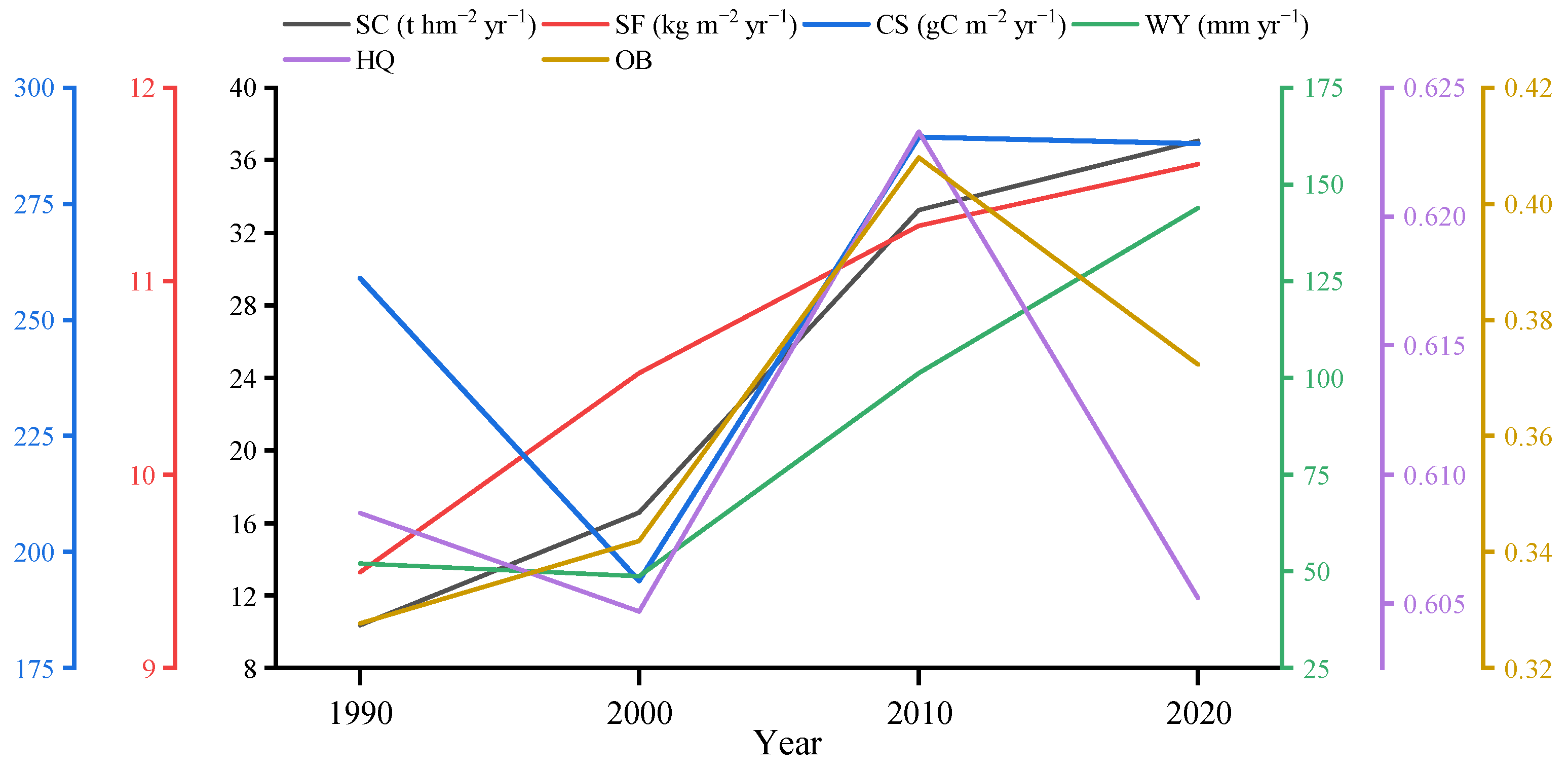
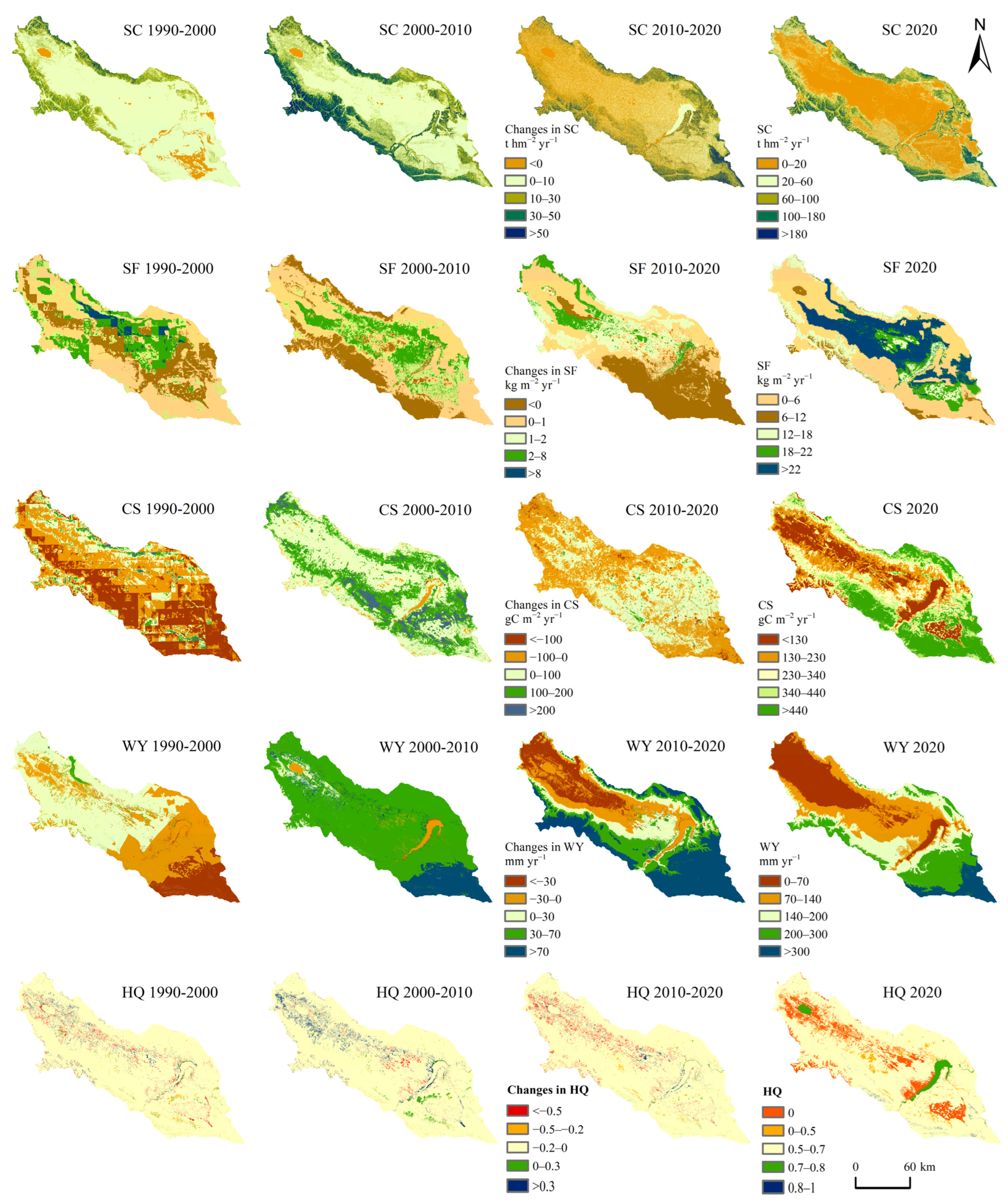
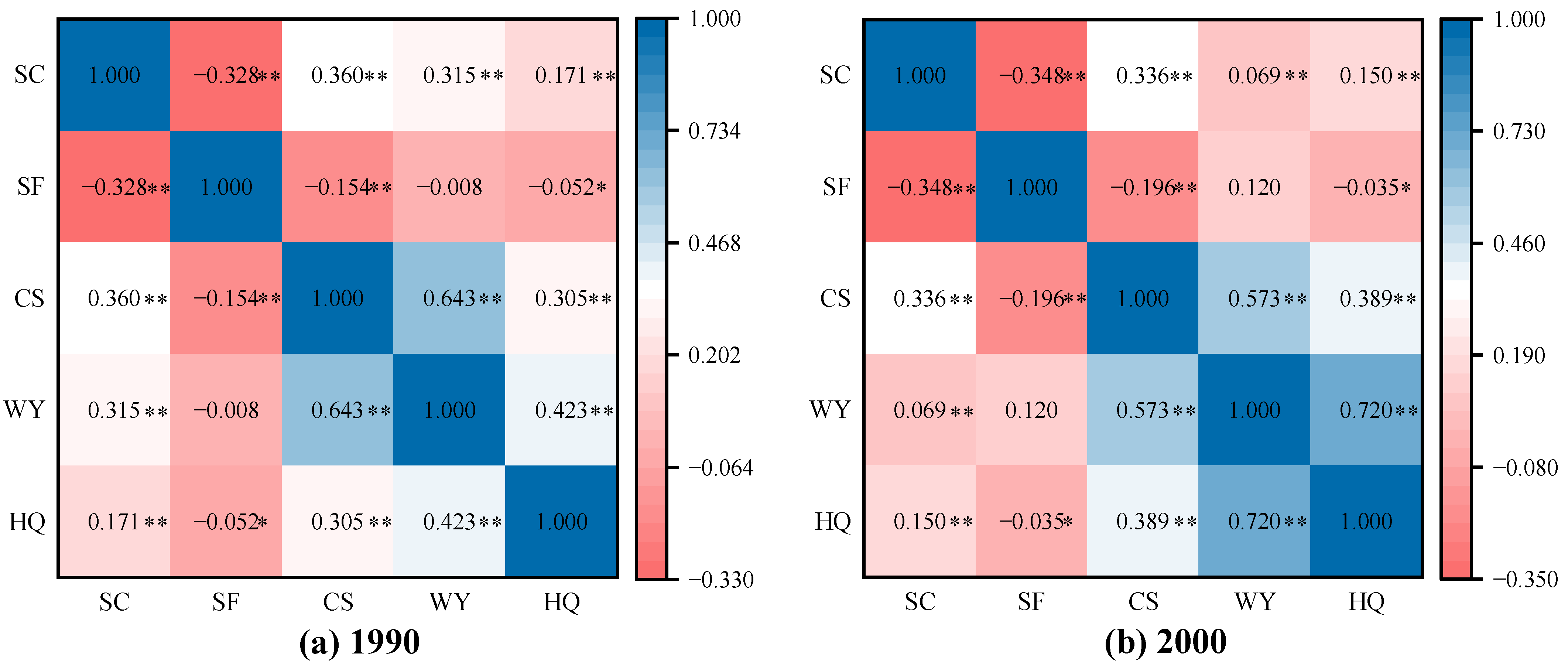
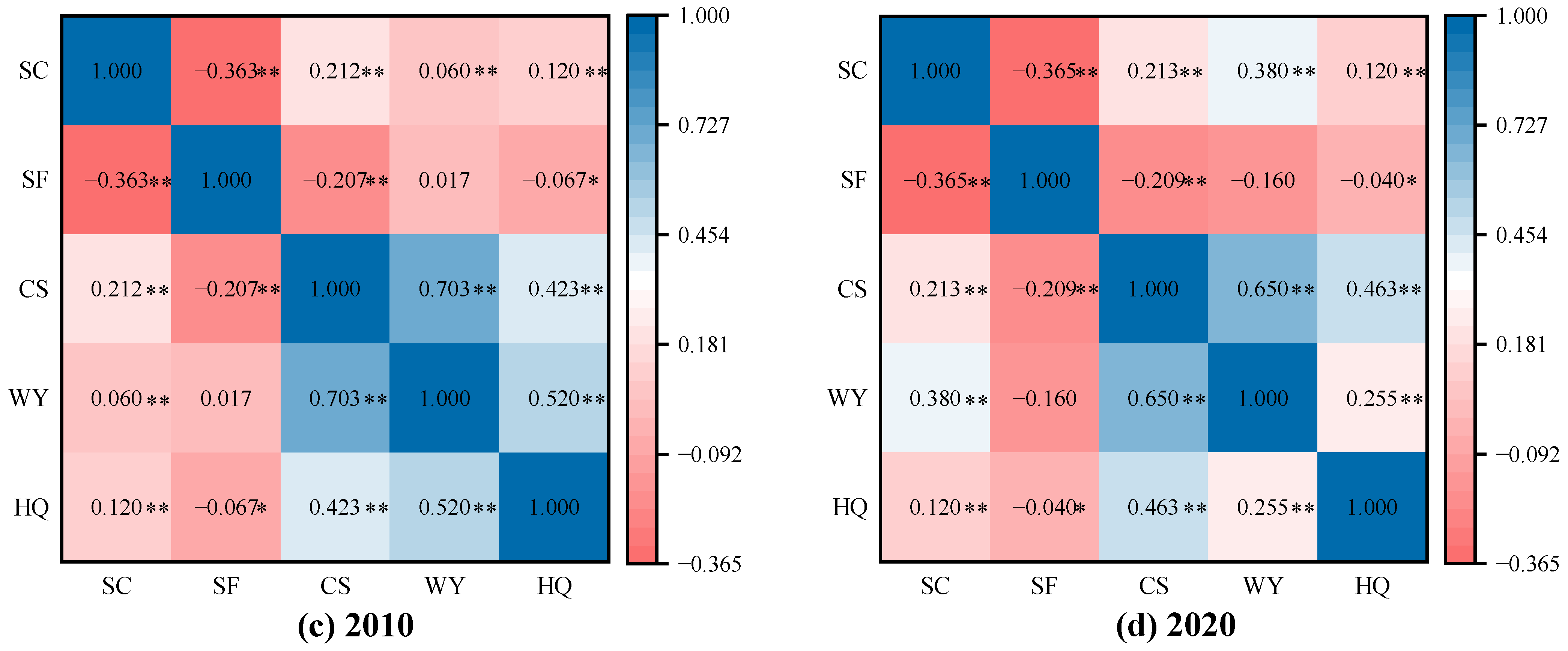
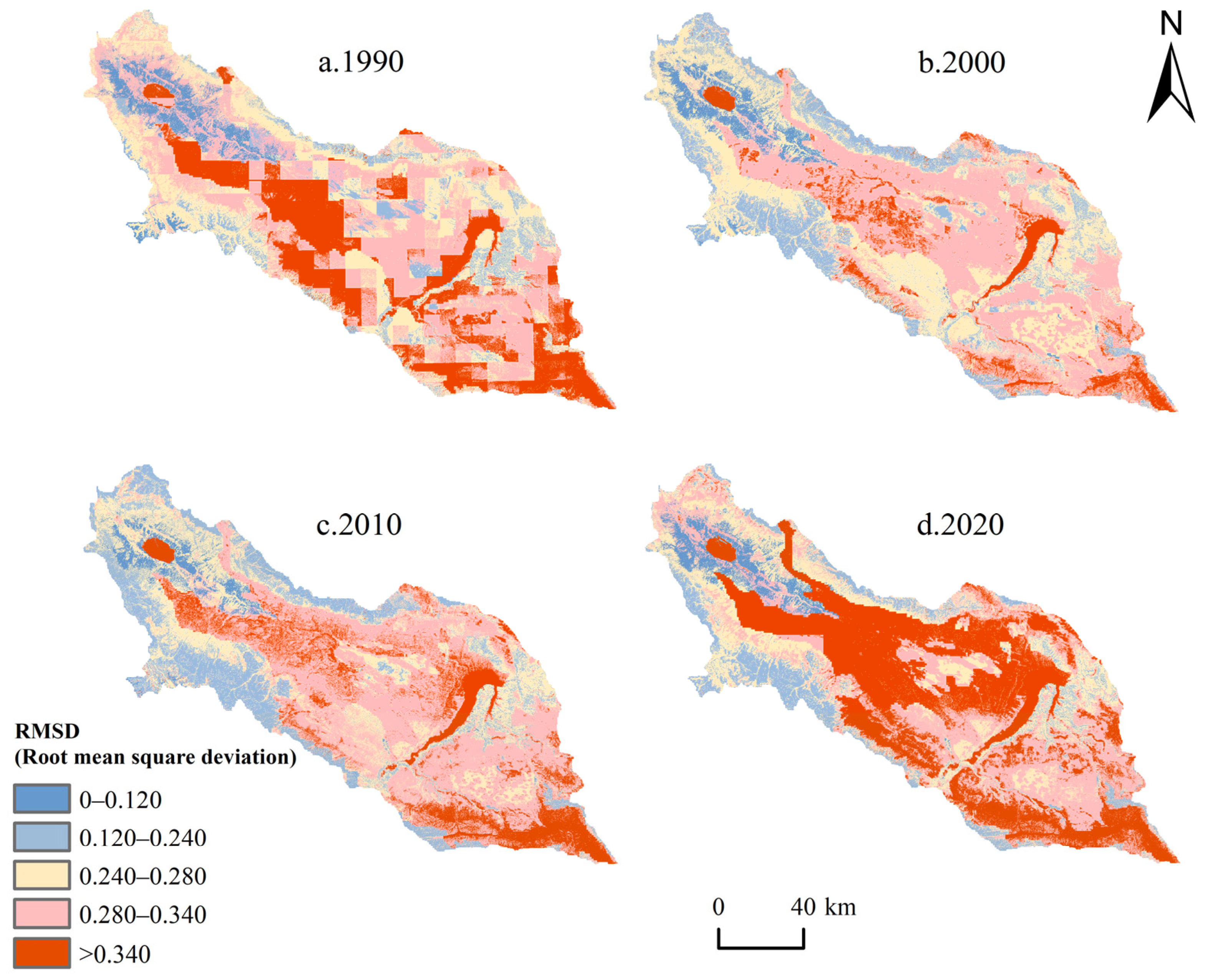
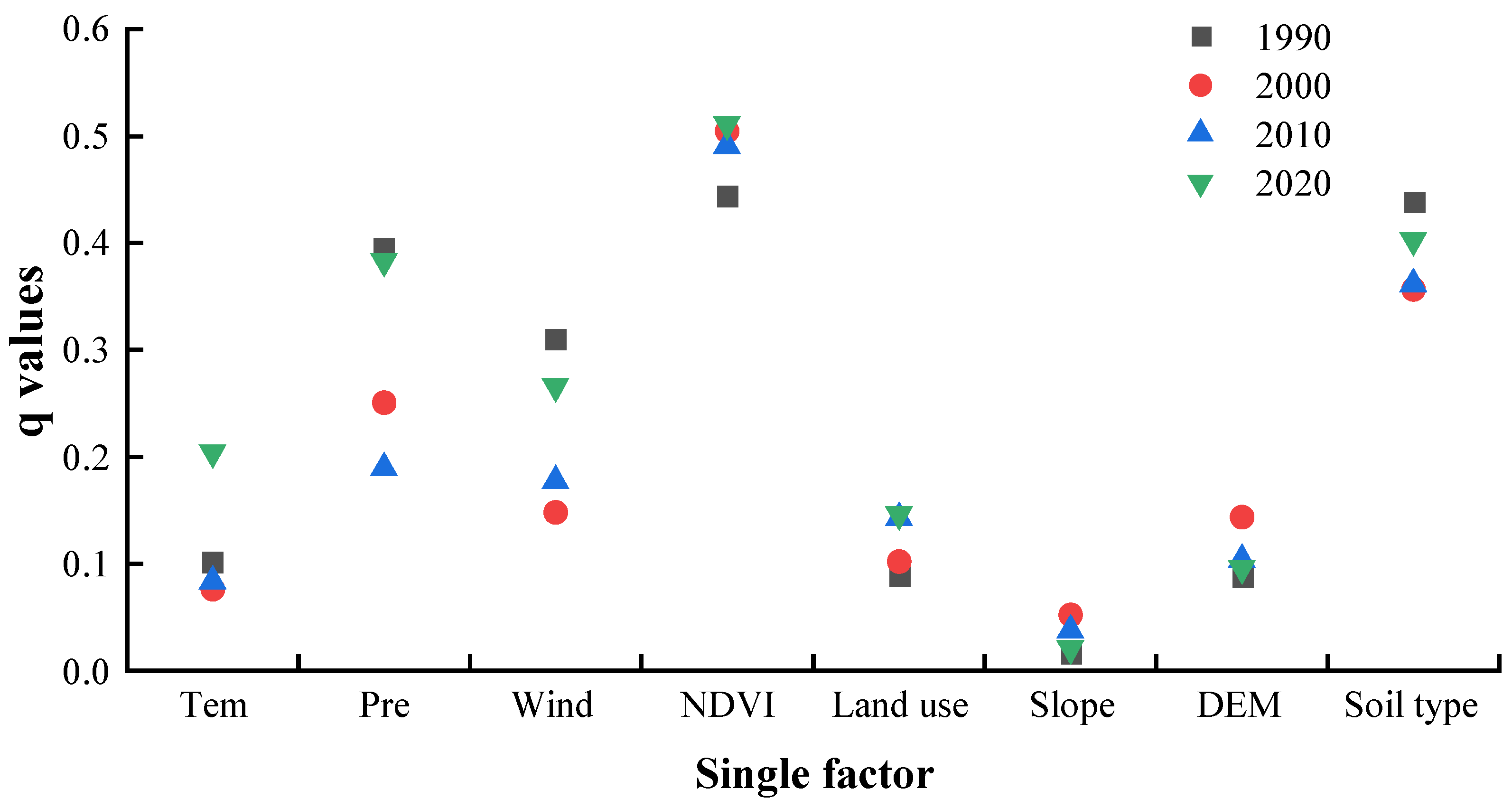
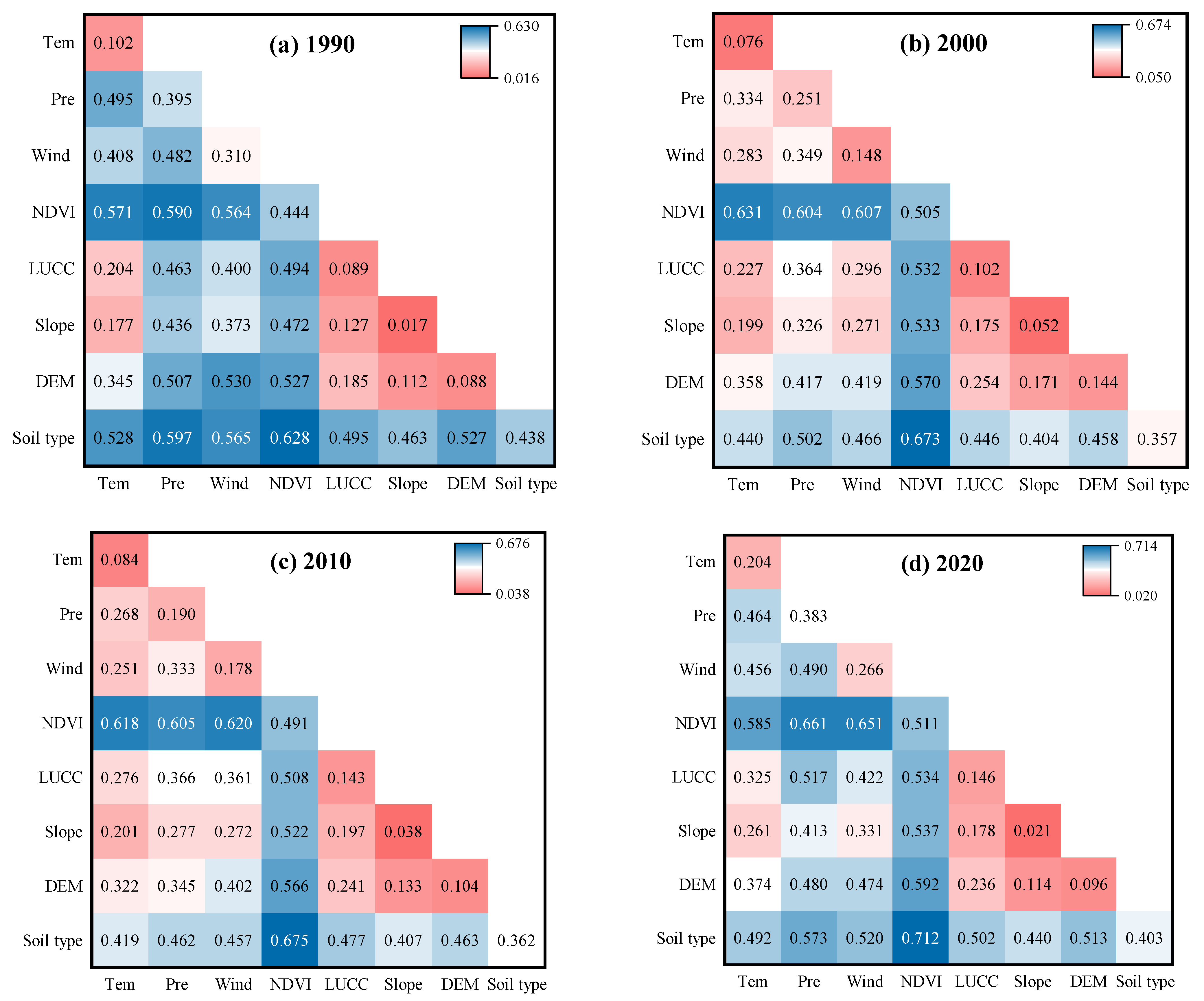


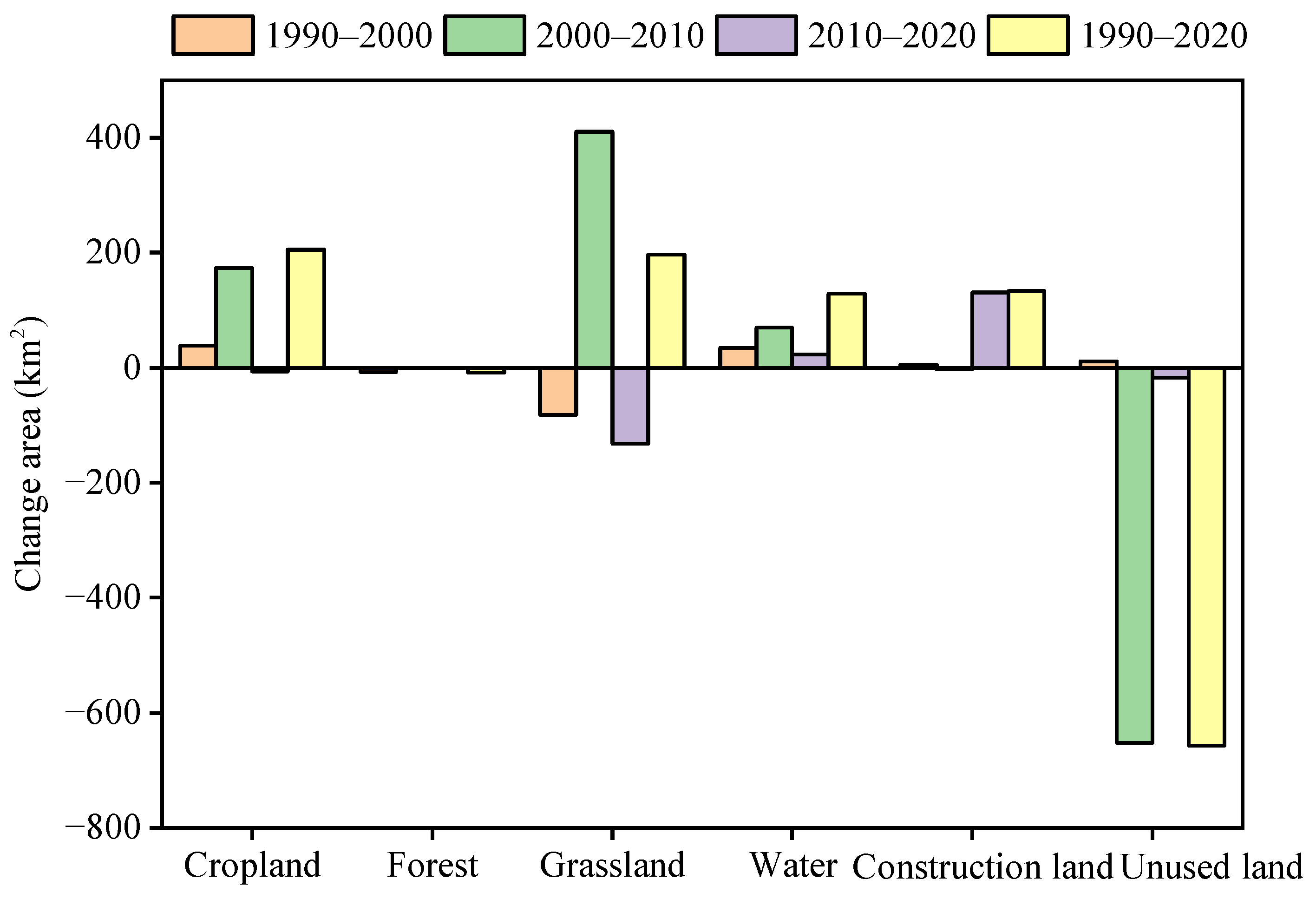
| Name | Temporal Resolution | Spatial Resolution | Period | Resource |
|---|---|---|---|---|
| Temperature Precipitation Wind speed | Daily | 30 m | 1990–2020 | China Meteorological Center |
| Snow depth | Daily | 0.25° × 0.25° | 1982–2020 | Long-term daily snow depth in China |
| NDVI | 15 d 16 d | 8 km 250 m | 1990–2015 2001–2020 | GIMMS-NDVI3g MOD13Q1 |
| Land cover | Annual | 30 m | 1990–2020 | China land cover dataset |
| DEM | – | 30 m | 2019 | ASTER GDEM V3 |
| Soil properties | – | 1 km | 2013 | HWSD V1.2 |
| Influencing Factor | 1990 | 2000 | 2010 | 2020 | ||||
|---|---|---|---|---|---|---|---|---|
| Suitable Range/Type | Value of OB | Suitable Range/Type | Value of OB | Suitable Range/Type | Value of OB | Suitable Range/Type | Value of OB | |
| Temperature (°C) | 3.24–3.61 | 0.399 | 1.47–1.97 | 0.409 | 5.21–5.57 | 0.479 | 5.62–6.26 | 0.476 |
| Precipitation (mm) | 380.61–425.80 | 0.502 | 290.07–315.57 | 0.477 | 425.50–452.20 | 0.538 | 598.61–782.52 | 0.520 |
| Wind speed (m/s) | 1.95–2.04 | 0.407 | 1.68–1.85 | 0.410 | 2.32–2.52 | 0.480 | 1.81–1.88 | 0.476 |
| NDVI | 0.64–0.75 | 0.447 | 0.71–0.99 | 0.483 | 0.69–0.78 | 0.508 | 0.69–0.78 | 0.491 |
| Land use type | Cropland | 0.395 | Forest | 0.433 | Cropland | 0.480 | Cropland | 0.454 |
| Slope (°) | 30.92–38.67 | 0.388 | 30.92–38.67 | 0.427 | 30.92–38.67 | 0.480 | 30.92–38.67 | 0.430 |
| DEM (m) | 3711–4013 | 0.418 | 3711–4013 | 0.466 | 3711–4013 | 0.514 | 3711–4013 | 0.476 |
| Soil type | Marsh soil | 0.499 | Alpine meadow soil | 0.491 | Alpine meadow soil | 0.518 | Alpine meadow soil | 0.513 |
| Influencing Factor | Classes Break Values | ||||||||
|---|---|---|---|---|---|---|---|---|---|
| 1 | 2 | 3 | 4 | 5 | 6 | 7 | 8 | 9 | |
| Temperature (°C) | 2.96 | 3.44 | 3.83 | 4.23 | 4.68 | 5.14 | 5.64 | 6.27 | 7.40 |
| Precipitation (mm) | 249.66 | 306.25 | 353.40 | 395.84 | 440.64 | 487.80 | 537.31 | 598.61 | 782.52 |
| Wind speed (m/s) | 1.87 | 1.91 | 1.95 | 1.99 | 2.03 | 2.07 | 2.11 | 2.15 | 2.21 |
| NDVI | 0.14 | 0.24 | 0.33 | 0.41 | 0.50 | 0.60 | 0.69 | 0.78 | 1.00 |
| Land use type | Cropland | Forest | Grassland | Water | Construction land | Unused land | — | — | — |
| Slope (°) | 4 | 7 | 12 | 17 | 22 | 29 | 37 | 72 | — |
| DEM (m) | 2814 | 3059 | 3241 | 3456 | 3711 | 4013 | 4409 | 5261 | — |
Disclaimer/Publisher’s Note: The statements, opinions and data contained in all publications are solely those of the individual author(s) and contributor(s) and not of MDPI and/or the editor(s). MDPI and/or the editor(s) disclaim responsibility for any injury to people or property resulting from any ideas, methods, instructions or products referred to in the content. |
© 2024 by the authors. Licensee MDPI, Basel, Switzerland. This article is an open access article distributed under the terms and conditions of the Creative Commons Attribution (CC BY) license (https://creativecommons.org/licenses/by/4.0/).
Share and Cite
Jia, H.; Yang, S.; Liu, L.; Wang, R.; Li, Z.; Li, H.; Liu, J. Distinguishing the Multifactorial Impacts on Ecosystem Services under the Long-Term Ecological Restoration in the Gonghe Basin of China. Remote Sens. 2024, 16, 2460. https://doi.org/10.3390/rs16132460
Jia H, Yang S, Liu L, Wang R, Li Z, Li H, Liu J. Distinguishing the Multifactorial Impacts on Ecosystem Services under the Long-Term Ecological Restoration in the Gonghe Basin of China. Remote Sensing. 2024; 16(13):2460. https://doi.org/10.3390/rs16132460
Chicago/Turabian StyleJia, Hong, Siqi Yang, Lianyou Liu, Rui Wang, Zeshi Li, Hang Li, and Jifu Liu. 2024. "Distinguishing the Multifactorial Impacts on Ecosystem Services under the Long-Term Ecological Restoration in the Gonghe Basin of China" Remote Sensing 16, no. 13: 2460. https://doi.org/10.3390/rs16132460






